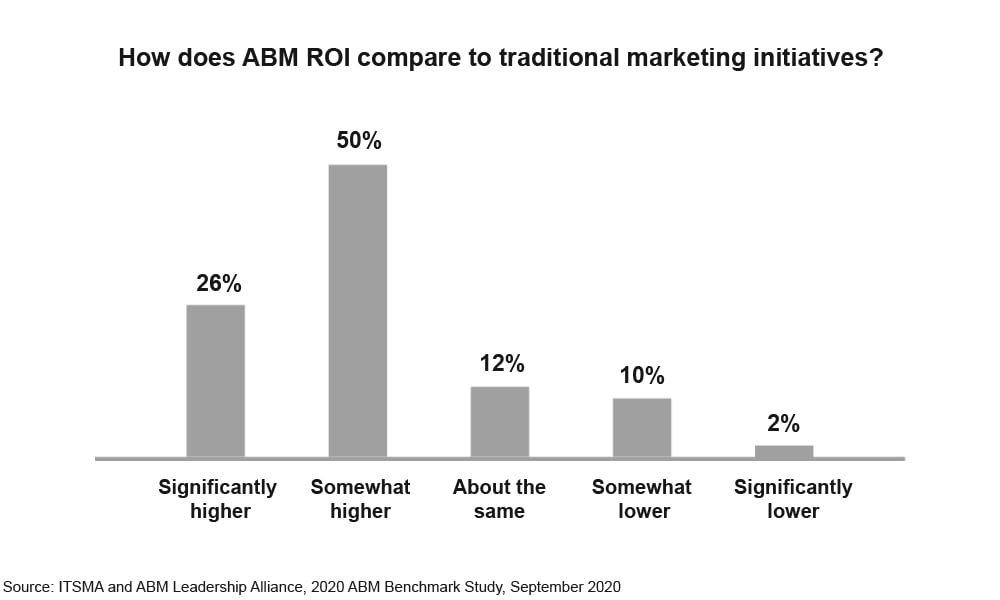- Learn
- The Onlinification Hub
- ABM: The key to a successful account-centric approach
ABM: The key to a successful account-centric approach

Are you a sales leader or rep who want to learn more about account-based marketing? In this article, you'll discover the key to a successful account-centric approach.
Technological development is pushing customer expectations to all-time highs and sales reps into uncharted territory. Today, sales reps are accountable for both quotas and customer success, giving them bigger mandates than ever before. New data-driven sales approaches such as account-based marketing (commonly referred to as ABM) are emerging in tandem with significant changes in customer engagement and an increasing need for cross-functional collaboration. As customers expect personalised, consultative engagement from companies, sales reps bear the brunt of the change.
ABM requires you to carefully plan which accounts will be targeted, which can be time-consuming and limits you to a smaller number of prospects. However, it is a powerful way to build trust, increase relevance to high-value accounts, and close big deals with a personalised customer experience.
According to Forrester's Q2 2019 International B2B Marketing ABM Panel Online Survey, 59% of mid-market/enterprise B2B decision-makers see a significant increase in per-account pipeline, 57% an increase in per-account revenue, and 69% an increase in cross-selling and up-selling from using ABM.
ABM is nothing new – the account-based approach has been practised in B2B marketing for a very long time. But what has changed over the years is the role and availability of useful information in the sales process. Marketing and sales can now rely on various marketing technology products such as HubSpot ABM Software and Demandbase ABM Platform (Engagio). Due to technical development, ABM has become highly efficient over the last few years.
The key to a successful account-centric approach
Sales and marketing alignment, quality data and personalisation are the keys to ABM success.
Sales and marketing alignment
ABM generates a better marketing ROI through precise, targeted, personalised, and measurable approaches in harmony between marketing and sales. ITSMA's and ABM Leadership Alliance's 2020 study shows that most B2B marketers surveyed consider the ROI of ABM to be higher than traditional marketing initiatives.

ABM has proven its effectiveness for many B2B companies, but it can only be successful if marketing and sales work closely together.
While general online marketing aims to generate a broad mass of leads through campaigns, ABM turns this process around. First, a company will be selected that should be acquired as a customer. In ABM, this is referred to as a targeted account. Marketing and sales work closely together to convince the targeted company with personalised content. The focus is on the decision-making unit - the group of people within the company that decides to buy or not. Dialogues, not just with one decision-maker but with the entire decision-making unit, will lead to a faster sales cycle. Furthermore, scatter losses are avoided, and the probability of closing a deal increases.
ABM can be seen as a kind of extension of inbound marketing. In the customer journey, it comes before the first phase or the awareness phase. The company is thus already addressed before it becomes aware of the offer on its own. Marketing and sales focus their energy, specifically on large customers who are likely to generate high sales in a shorter time frame. This enables them to organise their communications and focus on marketing activities more effectively.
Research the correct data in advance
Data insights are emerging as a critical asset for top sales teams and help with lead prioritisation. Historically, sales reps had to rely on intuition when weighing which opportunities to pursue — and how to nurture them. As salespeoples' mandates to develop deeper customer relationships have intensified, and as the influx of data insights increases, intuition is no longer the only means at their disposal.
Building relationships and communicating with the many individual contacts at the target account is complex and time-consuming. For ABM to work smoothly, you need to research the correct data in advance and learn everything about your account:
- Understand the account's business, strategy, objectives, and critical business initiatives.
- Identify the main stakeholders and decision-making units.
- Analyse the revenue of the account and how your products or services contribute to those numbers.
- Find your account's weak points and how you plan to strengthen them.
- List out the products/services that will help your account attain its goals, alongside revenue goals/projections and any blockers or potential objections.
- Compile a list of your account's competitors, as well as its comparative strengths and weaknesses.
Just knowing the names of your contacts is not enough — you need deep insights into the target company and its goals. Only with this knowledge can you adapt your marketing campaign to their needs. This account planning sheet can help you to plan your accounts.
Personalisation and scalability
Instead of relying on generic content that addresses an entire market, ABM treats individual customers as individual markets. In today's B2B environment, it's rare that only one person is involved in the buying decision. The benefit of ABM is that it addresses all stakeholders equally.
Each of these individuals pursues different individual goals within the corporate agenda and accordingly faces diverse challenges. Additionally, each of these individuals is incentivised differently and evaluates products or services from a different perspective. With ABM, individuals' needs and relationships are taken into account.
Traditionally, marketing prepares general information for a relatively broad audience, such as websites which aim to address all potential buyers. Meanwhile, sales focus on communicating more specific information through things like product demos, but these are typically also quite generic. ABM builds a bridge between generic information and targeted content. If, for example, a sales rep recognises that a decision-maker in a target account could respond to a product demo, sales, together with marketing, can prepare a customised webinar with a tailored demo that will grab the desired customer's attention.
In this way, the ideal customer receives valuable assistance tailored to their needs long before a deal is even close. The aim is to create a basis of trust between you and your target customer as early as possible. Answering a specific account's questions instead of trying to appeal to the masses will sharpen your expert positioning.
So how do you scale your personalised ABM approach to hundreds or even thousands of targeted accounts in various industries?
- Use the information in your CRM to segment your audience at the beginning.
- Reuse your content. Create role-specific content that you then refine with custom information. Or create an industry-standard message, then refine it with some tailor-made information.
- Use website personalisation tools and create smart, dynamic content that changes based on user behaviour and characteristics.
- Create targeted LinkedIn ads to reach lookalike accounts.
If you want to learn more about how ABM works, visit our complete ABM guide — and if you'd like to take the next step, get in touch with us.




